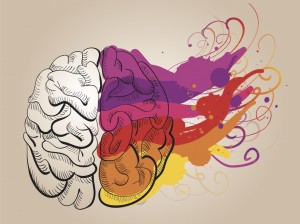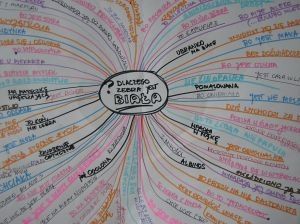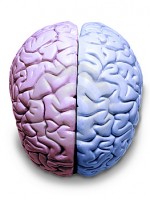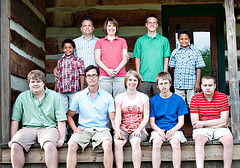I did a bunch of reading and a bunch of research before and during the writing of my book, The Right Side of Normal, but there’s so much to read, and so little time. I finally got around to reading The Gift of Dyslexia, by Ronald D. Davis and discovered here is yet another author who validates my thinking and theory that the gift of three-dimensional thinking is at the root of many of the differences right-brained learners show.
I wrote an introductory blog post about right-brained learning and the effects that three-dimensional thinking has on later acquisition of certain subjects here. I would like to elaborate more in this blog post.
Linda Kreger-Silverman said in her out-of-print book Upside-Down Brilliance:
The essence of visual-spatial is the three-dimensionality. Everything, every name, every fact, every piece of information is processed as a 3-D object.
From The Dyslexic Advantage, authors Drs. Brock and Fernette Eide define one of the gifts of those with dyslexia as:
…the kind of spatial reasoning at which they excel involves the creation of a connected series of mental perspectives that are three-dimensional in nature–like a virtual 3-D environment in the mind.
And from Thomas Armstrong in The Power of Neurodiversity, he writes:
…there was one visual-spatial ability in which dyslexics consistently came out on top: the recognition of impossible three-dimensional figures.
 The visual-spatial label is the same as the label I call a right-brained dominant person. In fact, research is showing those labeled with dyslexia are more right-brained dominant. The Eides say in The Dyslexic Advantage:
The visual-spatial label is the same as the label I call a right-brained dominant person. In fact, research is showing those labeled with dyslexia are more right-brained dominant. The Eides say in The Dyslexic Advantage:
…several kinds of evidence suggest that individuals with dyslexia differ from nondyslexics in the ways they use their brain hemispheres to process information. In particular, a growing body of research suggests that individuals with dyslexia use their right hemispheres more extensively for many processing tasks than do nondyslexics.
And Thomas Armstrong in The Power of Neurodiversity:
There even appear to be anatomical differences. In fluent readers, the left hemisphere of the brain is generally larger than the right. However, in dyslexic brains (based on the dissection of cadavers) the two hemispheres are more symmetrical, with the right hemisphere being more prominent.
In my list of right-brained traits (see the side bar to the right of this site or Chapter Five of my book here), I pinpoint the three-dimensional picture-based thinking of right-brained people as one of the two universal gifts (the other being a highly developed imagination). A universal gift means it’s common in all right-brained people. Now, mind you, there will be varying degrees of these gifts for each individual: a continuum, from mildly so to extremely so. Let’s talk about how the three-dimensional pictorial gift works. In The Gift of Dyslexia, Ronald Davis explains:
It is widely believed that human beings think in two different ways: “verbal conceptualization” and “nonverbal conceptualization.” Verbal conceptualization means thinking with the sounds of words. Nonverbal conceptualization means thinking with mental pictures of concepts or ideas.
He explains in his book that when you think verbally, it follows along at the speed of speech. That makes sense, doesn’t it? Language and sounds are involved with verbal ability, so it will be a strength of those who think verbally, or with words, or what I classify as a universal gift for left-brained learners. But  with those who think in pictures, Davis shares that the speed at which this information is processed is so fast, that it’s almost subliminal. Think about how we communicate nonverbally. We take things in so fast and naturally, that we don’t even realize how much we interpret nonverbally, until, that is, you have a child with autism, who has difficulty with nonverbal communication! Those who think in pictures take in concepts and ideas at that speed, in whole chunks. To understand the application of this, let’s hear the example that the Eides shared in their book, The Dyslexic Advantage, of Albert Einstein:
with those who think in pictures, Davis shares that the speed at which this information is processed is so fast, that it’s almost subliminal. Think about how we communicate nonverbally. We take things in so fast and naturally, that we don’t even realize how much we interpret nonverbally, until, that is, you have a child with autism, who has difficulty with nonverbal communication! Those who think in pictures take in concepts and ideas at that speed, in whole chunks. To understand the application of this, let’s hear the example that the Eides shared in their book, The Dyslexic Advantage, of Albert Einstein:
Although Einstein eventually became a talented writer, he once complained that thinking in words was not natural for him, and that his usual mode of thinking was nonverbal. To communicate verbally he needed first to “translate” his almost entirely nonverbal thoughts into words.
And in the words of Einstein from the Eides’ book:
[C]ombinatory play [with nonverbal symbols] seems to be the essential feature in productive thought–before there is any connection with logical construction in words or other kinds of signs which can be communicated to others…Conventional words or other signs have to be sought for laboriously only in a secondary stage.
Although it’s known that Einstein did struggle in his early childhood years, we all know his genius prevailed. What’s that about? The Eides explain that in their book, The Dyslexic Advantage:
The brain systems that help “translate” nonverbal ideas into words are some of the latest-developing parts of the brain. For many children and adolescents with dyslexia, difficulty putting complex ideas into words is a normal feature of development and one that diminishes with maturity.
Putting this altogether, what am I trying to say? The universal gift of three-dimensional pictorial thinking that all right-brained people enjoy (and is a gift to the world in many professions) requires parents and teachers to understand the natural development that showcases this ability. Instead of creating disability through using the scope and sequence currently followed in schools, parents and teachers should be focusing on subjects and skills that use the three-dimensional pictorial gift as a strength. Those are listed in my chart found here, or more fully discussed in Chapter Seven of my book, The Right Side of Normal.

One of the activities missing in our schools is the creative outlets, which enhances all the strengths and gifts of right-brained children.
During the foundational years of 5-7 years old, all learning should center in the gift areas of each respective brain processing preference. During the 8-10 year time frame, the brain naturally shifts developmentally to take in more of the opposite brain processing functions. In other words, right-brained children will be ready for more left-brained tasks during this time of 8-10 years old, such as 2-D processing of symbols found in reading and math facts. The translation of these symbols into written words will take place at the Integration Stage of 11-13 years old, as this translation ability is the hardest and is the latest-developing parts of the brain as indicated in the above quote. This doesn’t mean we do nothing in the early years to develop any of these later developing skills, as I share in my post here. There are most definitely things that right-brained children develop to prepare themselves for each of these developmental milestones. I talk about that at length in my book, The Right Side of Normal.
So, do I believe in what we call dyslexia? Yes and no. I do believe our following the left-brained measuring stick can cause issues for these particular thinkers. When we introduce reading at early ages for a right-brained child (5-7 years old is early), Davis shares what happens as a right-brained child uses his foundational trait of three-dimensionality:
When dyslexic people look at an alphabet letter…, within a split second they see dozens of different views–from the top, the sides and the back of the letter. In other words, the mind’s eye is mentally circling around the letter as though it were an object in three-dimensional space. It’s like a helicopter buzzing around, doing surveillance on a building…trying to recognize the object.
Davis feels that once these disorientations regarding a right-brained person’s struggle to view a two-dimensional symbol via their three-dimensional gift occurs, confusion begins and so does a person’s natural coping mechanism of trying to deal with the problem at hand. Davis feels that the coping mechanisms right-brained children invent causes what we view as dyslexia. However, think  about it, if we don’t put our right-brained children in a developmental inappropriate situation, then they won’t have to create poor coping strategies that escalate the problem, right? Again, it’s not about doing nothing. My chapters on reading development in my book, The Right Side of Normal, share the different skills and activities we can be doing with our right-brained children in the early years to prepare them to be great readers later. Another style of learning called Waldorf education also follows the right-brained time frame for learning to read. See this post about how the Waldorf method of learning to read develops.
about it, if we don’t put our right-brained children in a developmental inappropriate situation, then they won’t have to create poor coping strategies that escalate the problem, right? Again, it’s not about doing nothing. My chapters on reading development in my book, The Right Side of Normal, share the different skills and activities we can be doing with our right-brained children in the early years to prepare them to be great readers later. Another style of learning called Waldorf education also follows the right-brained time frame for learning to read. See this post about how the Waldorf method of learning to read develops.
So, one way dyslexia can exist is when we don’t understand and honor the natural learning path for right-brained children. The other way could be that if a child is extremely right-brained and three-dimensional, maybe his brain has a harder time transitioning into the use of left-brained skills and strengths. If we’re talking about just the traditional dyslexia symptoms, then if reading isn’t progressing by age 12, I might look into helping the transition. The good news in this area is that all the latest interventions are effective regardless of age.
Otherwise, I believe oftentimes the label dyslexia indicates a right-brained learner who is facing a mismatched learning environment and time frame. Other professionals are beginning to conclude the same thing. From the Eides:
Like a telescope, the concept of dyslexia is a human invention; and like a telescope it can either expand and clarify our view of individuals who struggle to read and spell or, used “the wrong way around,” it can cause our view of these individuals to shrink. Unfortunately, this “diminishing effect” is just what we believe has happened with the way the concept of dyslexia has been used.
And Thomas Armstrong’s view:
The trouble is that medical researchers generally have a disease-based perspective regarding the brain, not one that is focused on health and well-being…There are plenty of studies, for example, about what’s wrong with the left hemisphere of the brains of dyslexics. Little research, however, exists on an area in the right hemisphere that processes loose word associations and may be the source of poetic inspiration…
Rather than viewing people with dyslexia…as having “broken brains,” as some have done, I present strong evidence in this book (The Power of Neurodiversity) for extraordinary gifts in those individuals who might to many people seem least likely to possess them…
I am convinced we need to reject the “disease-based” thinking that too often dogs the lives of labeled individuals and embrace a more positive vision of who they are, and who they can become.
Believe me, I know it’s hard to stand up against the wave of pressure that sooner is better. That’s why I dedicated Chapter Four in my book to that topic. The thing is, if your child is suffering and miserable, something isn’t working. If he’s a right-brained learner, most likely it’s the left-brained measuring stick that’s interfering with his joyful learning path. When the right-brained developmental learning time frame is honored, you will discover that there’s a right side of normal.
Question: What ways do you see three-dimensionality working as a gift or strength in you or your child’s life? When does it interfere?
If you benefited from this content, please consider supporting me by buying access to all of my premium content for a one-time fee of $15 found here. This will even include a 50% off e-mail link toward a copy of my popular The Right Side of Normal e-book (regularly $11.95)!








Pingback: Let’s Pretend our Society Embraces the Right-Brained Learning Information… | The Right Side of Normal
Pingback: The Natural Learning Development for Right-Brained Children | The Right Side of Normal
Pingback: Your Child Might Be Right-Brained If … | The Right Side of Normal